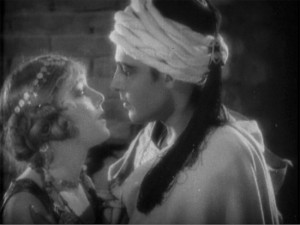Silent Films After The Artist and Hugo
Warning viewers about silent films is like warning Elmore Leonard fans that Henry James is a “slower” writer
/https://tf-cmsv2-smithsonianmag-media.s3.amazonaws.com/filer/20111222104108Garbo2_thumb.jpg)
Film geeks are a touchy bunch, and nothing gets their dander up like newbies making pronouncements about their territory. With both The Artist and Hugo likely to receive Oscar nominations, writers with little or no expertise in films of the 1920s are suddenly having to drum up opinions on what constitutes a good silent movie or why Georges Mèliés slipped into obscurity. (In Notebook, David Hudson gives amusing round-ups of coverage for both The Artist and Hugo.)
Meanwhile, die-hard fans of silents argue among themselves about whether The Artist and Hugo will bring about a surge in silent features. NitrateVille, the usually great, at times insufferable forum devoted to older movies, has long threads on both films, along with interminable arguments about the proper fps (frames per second) speed for projecting silents.
For raising hackles, it’s hard to beat the reaction to Bryony Dixon, “a silent film expert from the BFI” who threw out several opinions in an interview for the BBC. Her remark that, “You have to concentrate and this gives you a greater emotional involvement” when watching silents drew an extended rebuttal from Nick Redfern on his Research Into Film site. “I am aware of no research that compares the viewing pleasures derived from silent films to sound films,” Redfern begins, “and I have not been able to find any such research.” (Evidently he missed Rebecca Keegan’s 24 Frames blog posting on an fMRI study at the University of Southern California’s Brain and Creativity Institute that shows that silents engender a more complex creative process in the brain than sound films.)
Redfern’s efforts to apply scientific analysis to subjective opinions are as illogical as Matthew Sweet’s conclusion in the Telegraph that “Too late, we realise that silence was golden in the cinema“: “Why are we receptive once more to the pleasures of silent film? Because they are lost. Because it’s too late.”
Harold Lloyd in Safety Last, referenced in Martin Scorsese's Hugo.
Los Angeles Times film critic Kenneth Turan also wrote about the difference between watching sound and silent films. Comments like “For while sound particularizes, silence turns out to universalize, allowing an audience to share completely in the on-screen dream” would no doubt infuriate Mr. Redfern, but in a nice touch Turan also recommends four silent features: Seventh Heaven, Show People, A Throw of Dice, and The Unknown.
How difficult is it to watch a silent film? Well, they’re different, but they are still movies, just like Mission: Impossible—Ghost Protocol is a movie. Warning viewers about silents is like warning Elmore Leonard fans that Henry James is a “slower” writer. Just as you would when reading works by Dickens or Shakespeare, you have to accept the vocabulary and conventions of silent films in order to appreciate them. You might have to pay more attention watching Sunrise than We Bought a Zoo, but you’re also likely to feel more rewarded when you’re finished.
Here is another approach.
What do you like in contemporary movies? Do you like action films like Mission: Impossible or Sherlock Holmes? Then try a film like The Black Pirate by Douglas Fairbanks, who performed a lot of his own stunts. Or Clash of the Wolves, an action-packed thriller starring Rin Tin Tin. Or the original Last of the Mohicans, chock full of raids, chases, and massacres.
Do you prefer romance? Silent films by the director Frank Borzage, who directed over 100 titles, have an emotional power that is hard to match today. Lazybones and Lucky Star are as impressive as his big hit 7th Heaven. Films like Son of the Sheik, with Rudolph Valentino, or Flesh and the Devil, with Greta Garbo and John Gilbert, helped define screen romances.
Are you attracted to science fiction, or to spectacle? Try Fritz Lang’s delirious Frau im Mond (Woman in the Moon), or his newly restored Metropolis, or D.W. Griffith’s mammoth epic Intolerance, or Cecil B. DeMille’s original version of The Ten Commandments.
I’m convinced that silent comedies are every bit the equal of comedies made today. They are deft and light in ways that elude most present-day filmmakers. And there is a whole world of comedy to explore, not just well-known names like Chaplin and Buster Keaton, but brilliant performers like Charley Chase and Max Davidson.
When you decide on a silent film, try to see it in a movie theater. I recently introduced a screening of King Vidor’s World War I epic The Big Parade at New York’s Film Forum. Viewers afterward told me how amazed they were at the film’s scope and sophistication, aided immeasurably by Steve Sterner’s largely extemporaneous piano score. The experience of watching as part of an audience gave a special charge to the film.
/https://tf-cmsv2-smithsonianmag-media.s3.amazonaws.com/accounts/headshot/daniel-eagan-240.jpg)


/https://tf-cmsv2-smithsonianmag-media.s3.amazonaws.com/accounts/headshot/daniel-eagan-240.jpg)